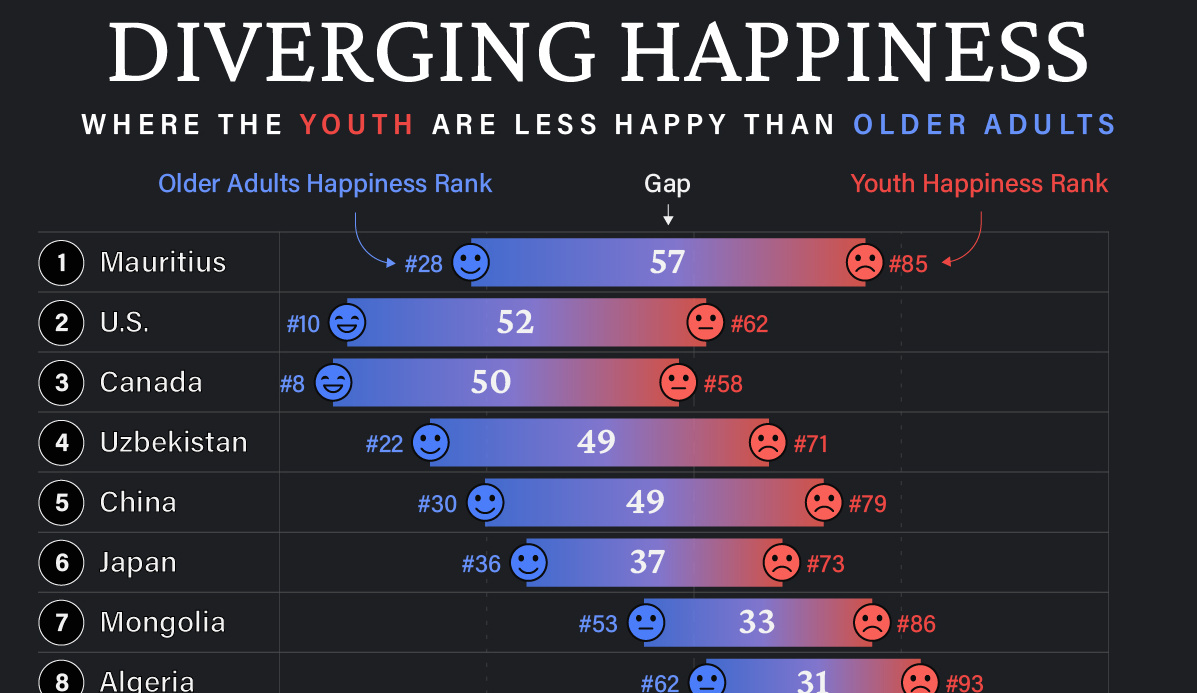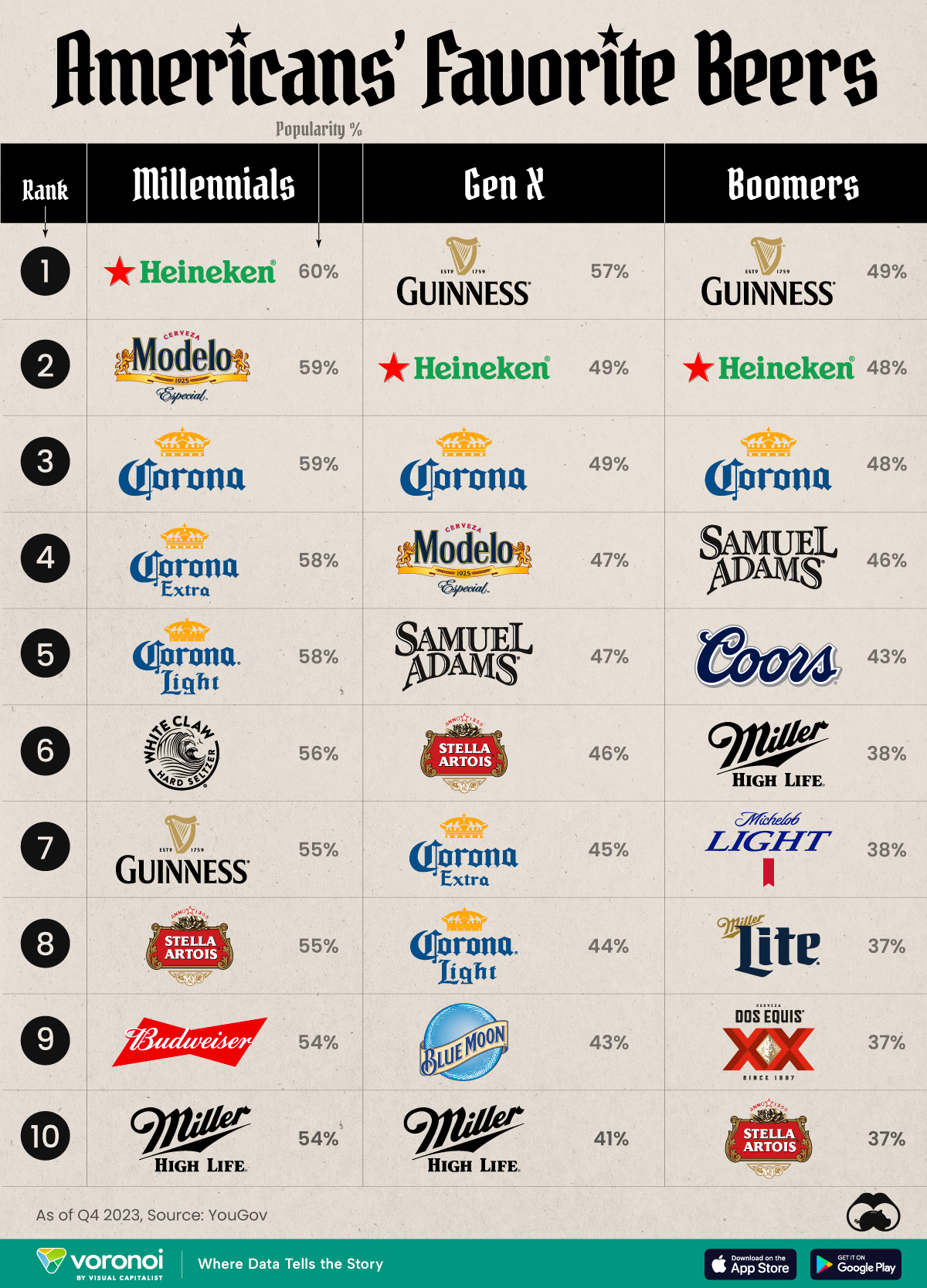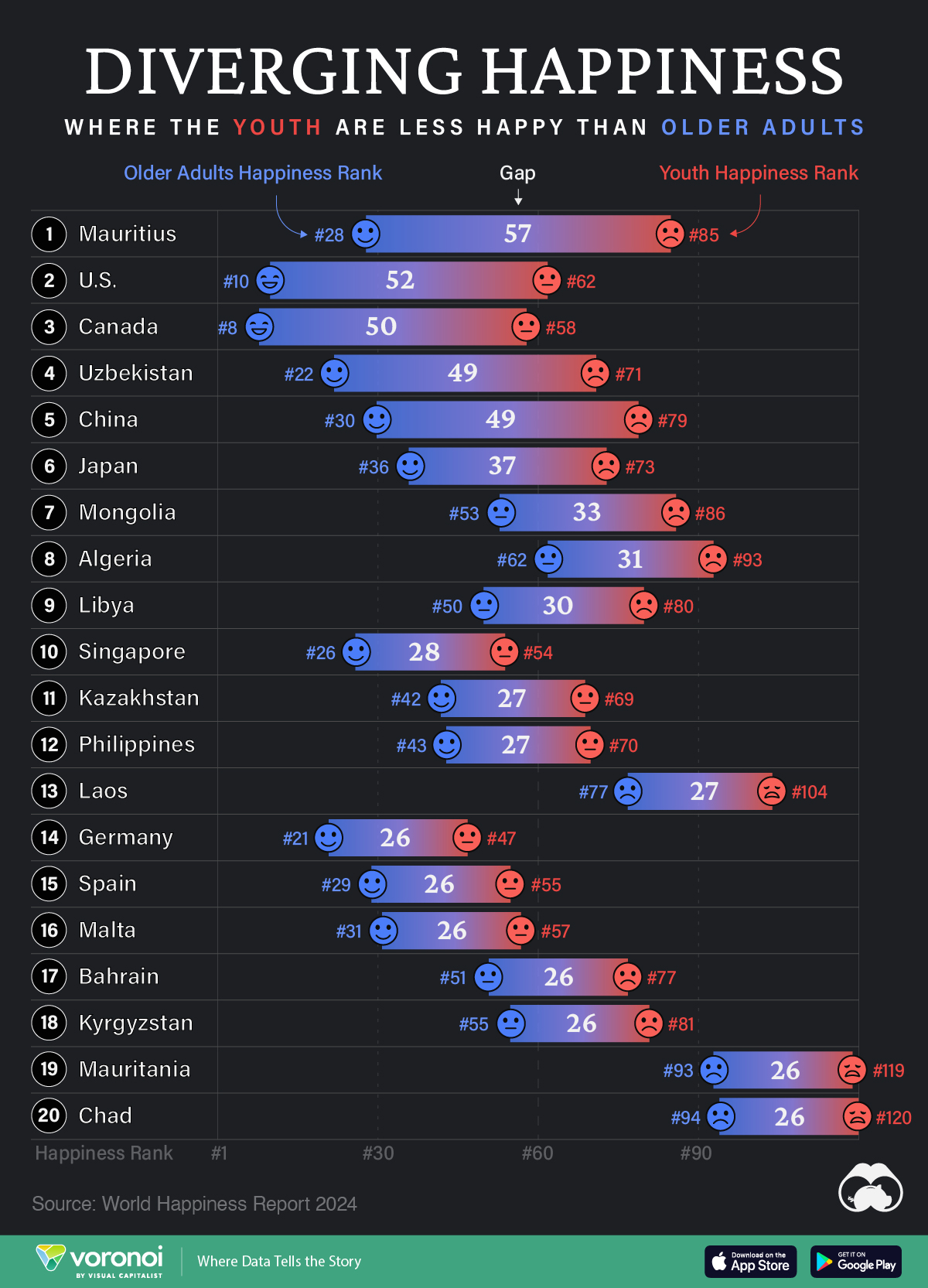Culture
Ranked: America’s Most Popular Beers, by Generation
![]() See this visualization first on the Voronoi app.
See this visualization first on the Voronoi app.
America’s Most Popular Beers, by Generation
This was originally posted on our Voronoi app. Download the app for free on iOS or Android and discover incredible data-driven charts from a variety of trusted sources.
In this graphic we’ve visualized the most popular beers for each U.S. generation as of Q4 2023, according to a consumer survey conducted by YouGov.
The “popularity” metric represents the % of people who had a positive opinion of that beer. Note that YouGov surveys are conducted with a representative sample of 1,500 respondents.
Overview: Millennials
U.S. millennials appear to favor foreign beers, with the top five spots taken by Dutch (Heineken) or Mexican beers (Modelo, Corona).
| Beer | Popularity (%) |
|---|---|
| 🇳🇱 Heineken | 60 |
| 🇲🇽 Modelo | 59 |
| 🇲🇽 Corona | 59 |
| 🇲🇽 Corona Extra | 58 |
| 🇲🇽 Corona Light | 58 |
| 🇺🇸 White Claw | 56 |
| 🇮🇪 Guinness | 55 |
| 🇧🇪 Stella Artois | 55 |
| 🇺🇸 Budweiser | 54 |
| 🇺🇸 Miller | 54 |
While not exactly a beer, White Claws (which have a similar alcohol content) claimed sixth place. Hard seltzers have become very popular in recent years due to their variety of flavors, attractive packaging, and relatively low amount of carbs and calories.
Overview: Gen X
Gen X also has a strong preference for foreign beers, particularly Guinness (fun fact: Over 31 million Americans claim to be of Irish descent).
| Beer | Popularity (%) |
|---|---|
| 🇮🇪 Guinness | 57 |
| 🇳🇱 Heineken | 49 |
| 🇲🇽 Corona | 49 |
| 🇲🇽 Modelo | 47 |
| 🇺🇸 Samuel Adams | 47 |
| 🇧🇪 Stella Artois | 46 |
| 🇲🇽 Corona Extra | 45 |
| 🇲🇽 Corona Light | 44 |
| 🇺🇸 Blue Moon | 43 |
| 🇺🇸 Miller | 41 |
Two American beers that weren’t on Millennials’ top 10 list are Samuel Adams and Blue Moon.
Samuel Adams is the flagship brand of the Boston Beer Company, named after U.S. Founding Father Samuel Adams. On the other hand, Blue Moon is a Belgian-style witbier brewed by Molson Coors.
Overview: Baby Boomers
Boomers’ top 10 favorite beers are similar to Gen X, with a few key differences. One is the absence of Modelo, which ranked second and fourth for Millennials and Gen X, respectively.
Modelo (which became America’s best-selling beer in 2023) has focused its advertising efforts on sports, which may not reach Boomers as effectively as younger generations.
| Beer | Popularity (%) |
|---|---|
| 🇮🇪 Guinness | 49 |
| 🇳🇱 Heineken | 48 |
| 🇲🇽 Corona | 48 |
| 🇺🇸 Samuel Adams | 46 |
| 🇺🇸 Coors | 43 |
| 🇺🇸 Miller | 38 |
| 🇺🇸 Michelob Light | 38 |
| 🇺🇸 Miller Lite | 37 |
| 🇲🇽 Dos Equis | 37 |
| 🇧🇪 Stella Artois | 37 |
An interesting pick for Boomers is Dos Equis, which is produced by Heineken-owned Cuauhtémoc Moctezuma Brewery. The brand gained popularity for its “most interesting man in the world” commercials, which ran from 2006 to 2018.
See More Beer Graphics 🍺
Be sure to check out this graphic which breaks down global beer consumption by country.
Demographics
Ranked: Countries Where Youth are the Most Unhappy, Relative to Older Generations
Conventional wisdom says that young adults (those below 30) tend to be the happiest demographic—but this is not true for these countries.

Countries with the Biggest Happiness Gaps Between Generations
This was originally posted on our Voronoi app. Download the app for free on iOS or Android and discover incredible data-driven charts from a variety of trusted sources.
“They say a person needs just three things to be truly happy in this world: someone to love, something to do, and something to hope for.” — Tom Bodett
Measuring happiness is tricky business, more so when taking into account how different regions, cultures, and faiths define it. Nevertheless, the World Happiness Report attempts to distill being happy into a single score out of 10, and then ranks countries by their average score.
We’ve visualized the high-level findings from the latest happiness report in this series of maps. However, the report also dives deeper into other significant trends in the data, such as a growing disparity in happiness between age groups within countries themselves.
In the chart above, we list countries by the biggest gaps in happiness ranks between young adults (<30) and older adults (60+). A higher number indicates a larger gap, and that the youth are far unhappier than their older counterparts.
Where are Youth Unhappier than Older Adults?
Mauritius ranks first on this list, with a massive 57 place gap between older adult and youth happiness. The 1.26 million-inhabited island nation briefly reached high income status in 2020, but the pandemic hit hard, hurting its key tourism sector, and affecting jobs.
The country’s youth unemployment rate spiked to close to 25% that year, but has since been on the decline. Like residents on many similarly-populated islands, the younger demographic often moves abroad in search of more opportunities.
| Rank | Country | Youth Happiness Rank | Older Adult Happiness Rank | Happiness Gap |
|---|---|---|---|---|
| 1 | 🇲🇺 Mauritius | 85 | 28 | 57 |
| 2 | 🇺🇸 U.S. | 62 | 10 | 52 |
| 3 | 🇨🇦 Canada | 58 | 8 | 50 |
| 4 | 🇺🇿 Uzbekistan | 71 | 22 | 49 |
| 5 | 🇨🇳 China | 79 | 30 | 49 |
| 6 | 🇯🇵 Japan | 73 | 36 | 37 |
| 7 | 🇲🇳 Mongolia | 86 | 53 | 33 |
| 8 | 🇩🇿 Algeria | 93 | 62 | 31 |
| 9 | 🇱🇾 Libya | 80 | 50 | 30 |
| 10 | 🇸🇬 Singapore | 54 | 26 | 28 |
| 11 | 🇰🇿 Kazakhstan | 69 | 42 | 27 |
| 12 | 🇵🇭 Philippines | 70 | 43 | 27 |
| 13 | 🇱🇦 Laos | 104 | 77 | 27 |
| 14 | 🇩🇪 Germany | 47 | 21 | 26 |
| 15 | 🇪🇸 Spain | 55 | 29 | 26 |
| 16 | 🇲🇹 Malta | 57 | 31 | 26 |
| 17 | 🇧🇭 Bahrain | 77 | 51 | 26 |
| 18 | 🇰🇬 Kyrgyzstan | 81 | 55 | 26 |
| 19 | 🇲🇷 Mauritania | 119 | 93 | 26 |
| 20 | 🇹🇩 Chad | 120 | 94 | 26 |
Conventional wisdom says, and data somewhat correlates, that young adults (those below 30) tend to be the happiest demographic. Happiness then decreases through middle age and starts increasing around 60. However, the above countries are digressing from the pattern, with older generations being much happier than young adults.
That older generations are happier, by itself, is not a bad thing. However, that younger adults are so much unhappier in the same country can point to several unique stresses that those aged below 30 are facing.
For example, in the U.S. and Canada—both near the top of this list—many young adults feel like they have been priced out of owning a home: a once key metric of success.
Climate anxieties are also high, with worries about the future of the world they’ll inhabit. Finally, persistent economic inequities are also weighing on the younger generation, with many in that cohort feeling like they will never be able to afford to retire.
All of this comes alongside a rising loneliness epidemic, where those aged 18–25 report much higher rates of loneliness than the general population.
Source: The World Happiness Report which leverages data from the Gallup World Poll.
Methodology: A nationally representative group of approximately 1,000 people per country are asked to evaluate their life on a scale of 0–10. Scores are averaged across generations per country over three years. Countries are ranked by their scores out of 10.
-

 Personal Finance1 week ago
Personal Finance1 week agoVisualizing the Tax Burden of Every U.S. State
-

 Misc6 days ago
Misc6 days agoVisualized: Aircraft Carriers by Country
-

 Culture6 days ago
Culture6 days agoHow Popular Snack Brand Logos Have Changed
-

 Mining1 week ago
Mining1 week agoVisualizing Copper Production by Country in 2023
-

 Misc1 week ago
Misc1 week agoCharted: How Americans Feel About Federal Government Agencies
-

 Healthcare1 week ago
Healthcare1 week agoWhich Countries Have the Highest Infant Mortality Rates?
-

 Demographics1 week ago
Demographics1 week agoMapped: U.S. Immigrants by Region
-

 Maps1 week ago
Maps1 week agoMapped: Southeast Asia’s GDP Per Capita, by Country















